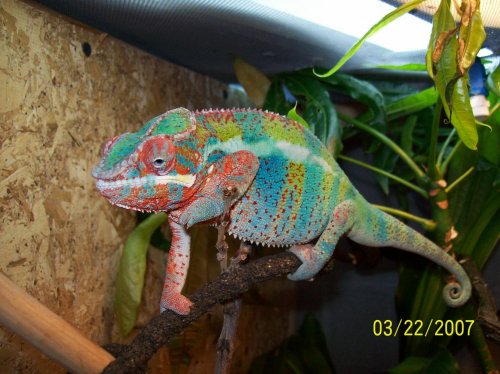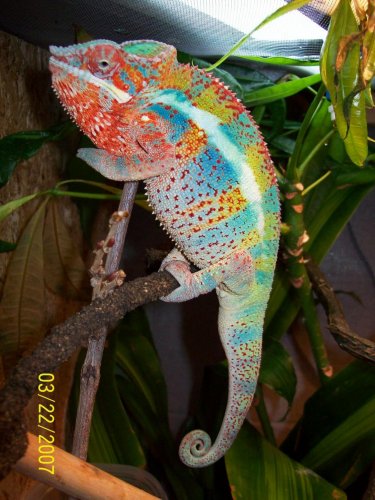Eric Adrignola
Avid Member
In the overall picture, there's nothing "wrong" with crossing color
variants.
In the ethics dept., they COULD be som bad stuff associated with this,
if someoen wants to mis-represent their animals as "pure" it could f-up
the gene pool on the locales. But, we dont' have to worry about this, as
we all know there arent' any people that would be willing to be
unethical to make a dollar.......
I believe we should maintain the pure strains, as they are representative
of the natural coloration that was isolated, via some selective forces, on
their native island. I'm guessing a lot of it is sexual selection, having to
do with the females being more receptive/attracted to a particular
coloration. The males with that coloration stand out more, and
eventually, the coloration becomes more represented in the gene pool.
You have to understand, that there is only so much we can do to
maintain natural conditions - we can only go so far, any further, and
we're fooling ourselves into believing we're replicating nature. We
aren't going to cull 80% of a clutch of Ambilobes, are we? What's the
survival rate, per clutch in the wild? We're letting many undesirable
traits make it to breeding. Someof the colors we seek might be not be
really representative of the natural colors. They might be selected
AGAINST in the wild. They might be connected to other problem
genes, for all we know.
We cannot preserve nature. We can only try to preserve aspects of
nature. In the case of pardalis, we try to preserve a coloration that is
localized. We do it for a few reasons, some more "noble" than others.
Ultimatly, the biggest factor in all this is money. There is a HUGE
market for "Pure" pardalis morphs.
THE reason 100% ambilobe, Nosey Be, and Ambanjas go for $200+
is because of demand. There is less demand for hybrids, cause nobody
knows what the heck it's gonna look like.
Produce a hybrid that is solid red with blue bars and flares up to have
colors unlike anything - it'll sell. Produce a solid blue chameleon with
weird striping and bright colors, it'll sell.
Produce a hybrid with a good mix of colors, but nothing defines, and
nothign really oputstanding...it aint' going to sell.
I hear many people claiming that breeders mix pardalis for greed - I
think that is completely wrong. There is far more profit in breeding
"pure" color morphs. In fact, it's the desire for pure color morphs that
has the pardalis market so high.
Profit isn't bad in this case -it's helped us maintain a pedigree of sorts,
so we can maintain some aspect of madagasgar in tact, not jut the
species.
When a new morph (as opposed to locale) is bred by mixing local;es,
then selectivly breeding the offspring, it'll keep itself "pure" because of
demand. That same market force will keep them from mixing with
other "pure" color morphs.
As it stands now, most mixes are uglier than the pure ones. I'm sure,
with time, and money, and VERY selective breeding, we'll see new
colorations spring up to rival the wild ones. I believe there's nothing
wrong with this, as long as the natural lines are maintained.
I'm trying to be selective with my calyptratus breeding. I've seen
variation in the clutches, one clutch I had over a decade ago, spawned
some males 9" TL, and some were 15", TL. The father was a small,
12" WC. I'm guessing many of them wouldnt' have made it to mate in
the wild, even if they survived. We're probably seeing a lot with
pardalis as well - many of the smaller ones, that would never be able to
defend a territory, get to mate in captivity now.
I try to "pseudo-cull" my veileds. I raise them up for 2-3 months, and
separate the "breeders". I will sell those to the people that want to
breed them responsibly, and sell the smaller ones as pets, at the shows,
to people that don't want to breed them. Not doing this can have quite
a deleterious effect of captive gene pools over just a few generations.
variants.
In the ethics dept., they COULD be som bad stuff associated with this,
if someoen wants to mis-represent their animals as "pure" it could f-up
the gene pool on the locales. But, we dont' have to worry about this, as
we all know there arent' any people that would be willing to be
unethical to make a dollar.......
I believe we should maintain the pure strains, as they are representative
of the natural coloration that was isolated, via some selective forces, on
their native island. I'm guessing a lot of it is sexual selection, having to
do with the females being more receptive/attracted to a particular
coloration. The males with that coloration stand out more, and
eventually, the coloration becomes more represented in the gene pool.
You have to understand, that there is only so much we can do to
maintain natural conditions - we can only go so far, any further, and
we're fooling ourselves into believing we're replicating nature. We
aren't going to cull 80% of a clutch of Ambilobes, are we? What's the
survival rate, per clutch in the wild? We're letting many undesirable
traits make it to breeding. Someof the colors we seek might be not be
really representative of the natural colors. They might be selected
AGAINST in the wild. They might be connected to other problem
genes, for all we know.
We cannot preserve nature. We can only try to preserve aspects of
nature. In the case of pardalis, we try to preserve a coloration that is
localized. We do it for a few reasons, some more "noble" than others.
Ultimatly, the biggest factor in all this is money. There is a HUGE
market for "Pure" pardalis morphs.
THE reason 100% ambilobe, Nosey Be, and Ambanjas go for $200+
is because of demand. There is less demand for hybrids, cause nobody
knows what the heck it's gonna look like.
Produce a hybrid that is solid red with blue bars and flares up to have
colors unlike anything - it'll sell. Produce a solid blue chameleon with
weird striping and bright colors, it'll sell.
Produce a hybrid with a good mix of colors, but nothing defines, and
nothign really oputstanding...it aint' going to sell.
I hear many people claiming that breeders mix pardalis for greed - I
think that is completely wrong. There is far more profit in breeding
"pure" color morphs. In fact, it's the desire for pure color morphs that
has the pardalis market so high.
Profit isn't bad in this case -it's helped us maintain a pedigree of sorts,
so we can maintain some aspect of madagasgar in tact, not jut the
species.
When a new morph (as opposed to locale) is bred by mixing local;es,
then selectivly breeding the offspring, it'll keep itself "pure" because of
demand. That same market force will keep them from mixing with
other "pure" color morphs.
As it stands now, most mixes are uglier than the pure ones. I'm sure,
with time, and money, and VERY selective breeding, we'll see new
colorations spring up to rival the wild ones. I believe there's nothing
wrong with this, as long as the natural lines are maintained.
I'm trying to be selective with my calyptratus breeding. I've seen
variation in the clutches, one clutch I had over a decade ago, spawned
some males 9" TL, and some were 15", TL. The father was a small,
12" WC. I'm guessing many of them wouldnt' have made it to mate in
the wild, even if they survived. We're probably seeing a lot with
pardalis as well - many of the smaller ones, that would never be able to
defend a territory, get to mate in captivity now.
I try to "pseudo-cull" my veileds. I raise them up for 2-3 months, and
separate the "breeders". I will sell those to the people that want to
breed them responsibly, and sell the smaller ones as pets, at the shows,
to people that don't want to breed them. Not doing this can have quite
a deleterious effect of captive gene pools over just a few generations.








